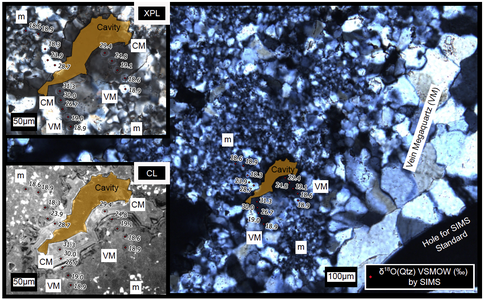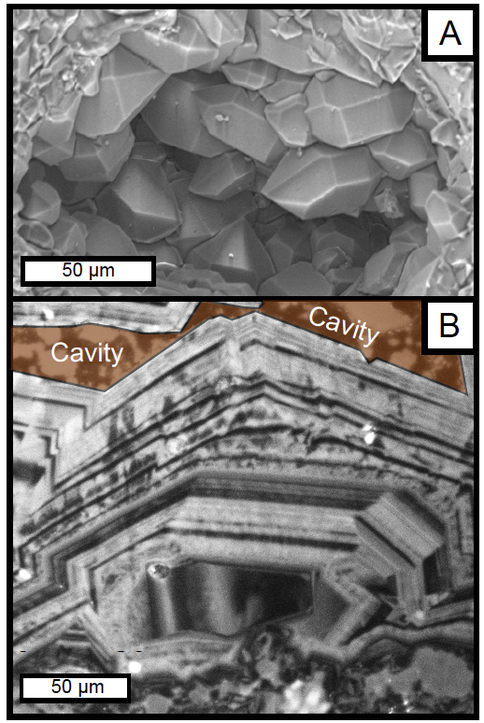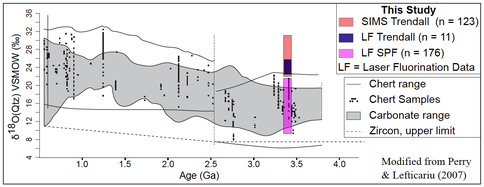2015 Annual Science Report
 University of Wisconsin
Reporting | JAN 2015 – DEC 2015
University of Wisconsin
Reporting | JAN 2015 – DEC 2015
Project 3E: Genesis of High-δ18O Archean Chert, Pilbara Craton, Australia
Project Summary
The cherts of the Strelley Pool formation host the oldest generally accepted evidence of life, stromatolites, organic matter and microfossils. Oxygen isotope ratios provide independent evidence to evaluate conditions when quartz formed. These results support habitable conditions during formation of early quartz and late alteration for genesis of late high δ18O-quartz.
Project Progress
Regional-, outcrop-, mm-, and µm-scale observations and analyses of δ18O(Qtz) have been used to characterize and interpret chert petrogenesis in the 3.4 Ga Strelley Pool Fm of the Pilbara Craton, Western Australia. SIMS δ18O(Qtz) analyses of cherts (Fig. 1) have revealed µm-scale petrographic textures that correlate to δ18O(Qtz) values that were homogenized using traditional bulk mm-scale laser fluorination δ18O(Qtz) analysis (Cammack et al. 2015a,b,c, Cammack 2015).
Foliated cherts from Camel Creek are metamorphosed by the adjacent Corunna Downs granitic complex. The basal detrital members of the Strelley Pool Fm at Unconformity Ridge have early, quartz-overgrowths that formed during compaction, and pressure-solution. Later, sandstone cements formed during hydrothermal circulation (Valley et al. 2015). Hydrothermally altered detrital quartz at Unconformity Ridge is sourced from the underlying Coonterunah Formation. The Trendall Locality has the highest and most variable δ18O(Qtz) values reported from Archean chert (Fig. 1). Values correlate to specific quartz textures indicating hydrothermal activity was less intense than at the other localities as evidenced by preservation of massive and stromatolitic dolomite outcrops, and elevated δ18O early-formed microquartz relative. The highest quartz δ18O values (17.9 to 31.3 ‰) at Trendall occur in late-forming cavity megaquartz (Fig. 2,3).
Regional greenschist facies metamorphism of the Strelley Pool Formation is not supported by this study. Hydrothermal alteration halos in igneous units adjacent to the Strelley Pool Fm; preservation of texture-specific, heterogeneous, µm-scale δ18O(Qtz) values; and δ18O(Qtz) differences in sampling localities suggests variable-intensity hydrothermal activity is the dominant post-depositional alteration process in the Strelley Pool Formation; the Trendall locality is least altered.
The δ18O values of early quartz within the Strelley Pool Fm does not record thermal or isotopic equilibrium with ambient seawater. In the context of the continued debate on the mechanisms responsible for the secular δ18O trend of cherts (Fig. 1) we propose that the record is biased and mistakenly compares Archean cherts affected by hydrothermal activity in volcanic greenstone belts to younger cherts that formed by diagenetic processes in basinal settings.
Publications
-
Pollington, A. D., Kozdon, R., Anovitz, L. M., Georg, R. B., Spicuzza, M. J., & Valley, J. W. (2016). Experimental calibration of silicon and oxygen isotope fractionations between quartz and water at 250°C by in situ microanalysis of experimental products and application to zoned low δ30Si quartz overgrowths. Chemical Geology, 421, 127–142. doi:10.1016/j.chemgeo.2015.11.011
- Cammack JN (2015) SIMS Microanalysis of the Strelley Pool Formation Cherts and the Implications for the Secular-Temporal Oxygen-isotope Trend of Cherts. MS thesis, UW-Madison, 357 p.
- Cammack JN, Kitajima K, Denny AC and Linzmeir BJ (2015a) Integrating microanalytical data with QGIS. 2015 HiResProxies of Paleoclimate Conference, abst. Madison, WI, p. 13-14
-
PROJECT INVESTIGATORS:
-
PROJECT MEMBERS:
Jake Cammack
Co-Investigator
Noriko Kita
Co-Investigator
Kouki Kitajima
Co-Investigator
Reinhard Kozdon
Co-Investigator
Mike Spicuzza
Co-Investigator
Martin Van Kranendonk
Collaborator
-
RELATED OBJECTIVES:
Objective 1.1
Formation and evolution of habitable planets.
Objective 4.1
Earth's early biosphere.
Objective 7.1
Biosignatures to be sought in Solar System materials




